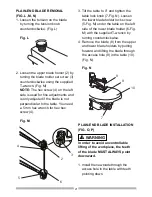
6
7
6
7
11.
WEAR PROPER APPAREL
. Do
not wear loose clothing, gloves,
neckties, rings, bracelets or other
jewelry which may get caught in
moving parts. Nonslip footwear is
recommended. Wear protective
hair covering to contain long hair.
12.
ALWAYS WEAR EYE
PROTECTION
. Any power
tool can throw foreign
objects into the eyes and
could cause permanent
eye damage.
ALWAYS
wear Safety
Goggles (not glasses) that comply
with ANSI Safety standard Z87.1.
Everyday eyeglasses have only
impact–resistant lenses. They
ARE NOT
safety glasses. Safety
Goggles are available at Sears.
NOTE
: Glasses or goggles not in
compliance with ANSI Z87.1 could
seriously injure you when they
break.
13.
WEAR A FACE MASK OR DUST
MASK
. Sawing operation produces
dust.
14.
SECURE WORK
. Use clamps or
a vise to hold work when
practical. It is safer than
using your hand and
it frees both hands to
operate the tool.
15.
DISCONNECT TOOLS FROM
POWER SOURCE
before servicing,
and when changing accessories
such as blades, bits and cutters.
16.
REDUCE THE RISK OF
UNINTENTIONAL STARTING
.
Make sure switch is in the OFF
position before plugging the tool in.
17.
USE RECOMMENDED
ACCESSORIES
. Consult
this Operator’s Manual for
recommended accessories. The
use of improper accessories may
cause risk of injury to yourself or
others.
18.
NEVER STAND ON THE TOOL
.
Serious injury could occur if the
tool is tipped or if the cutting tool is
unintentionally contacted.
19.
CHECK FOR DAMAGED PARTS
.
Before further use of the tool, a
guard or other part that is damaged
should be carefully checked to
determine that it will operate
properly and perform its intended
function – check for alignment of
moving parts, binding of moving
parts, breakage of parts, mounting
and any other conditions that may
affect its operation. A guard or
other part that is damaged should
be properly repaired or replaced.







































